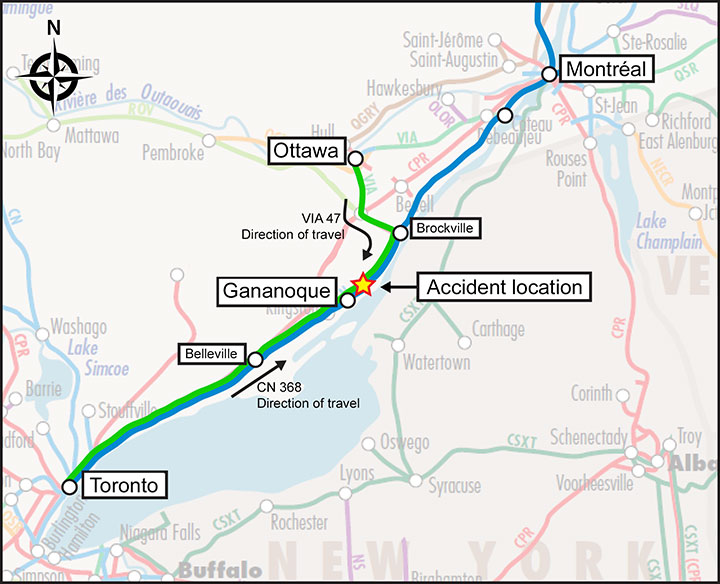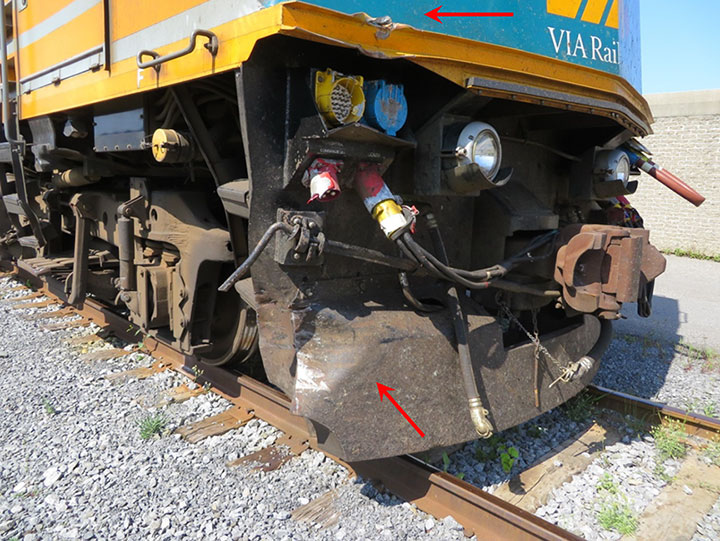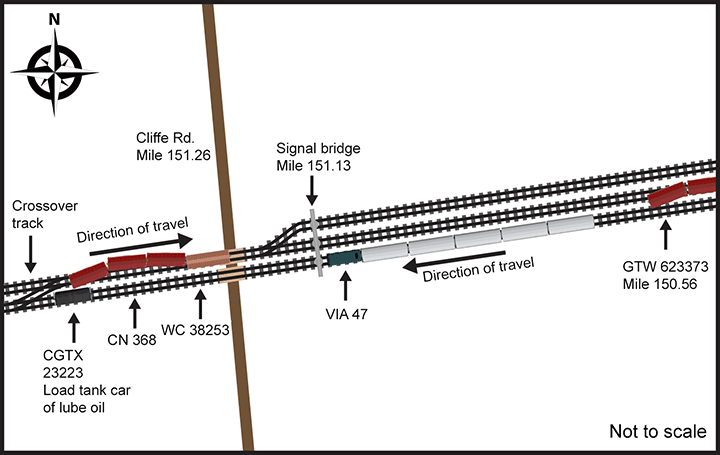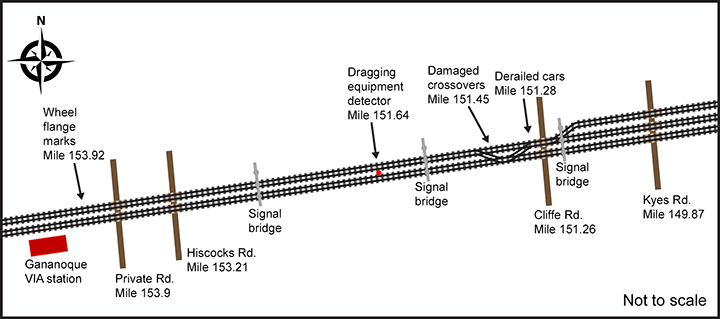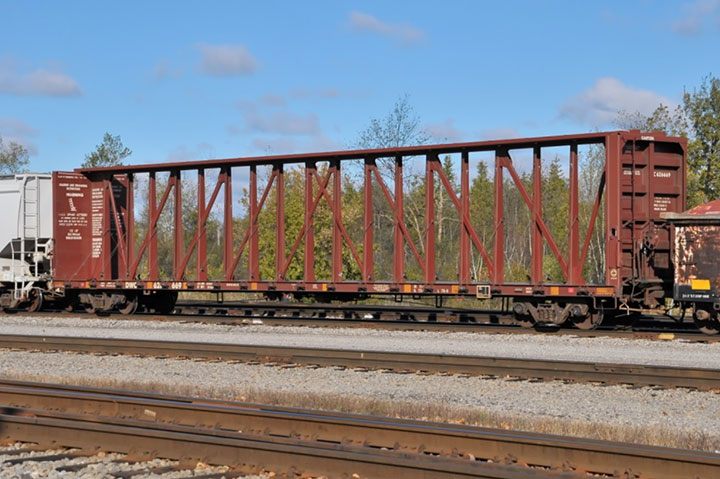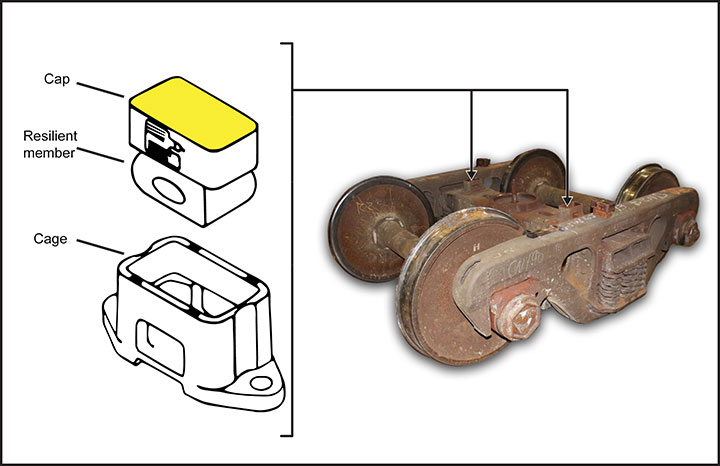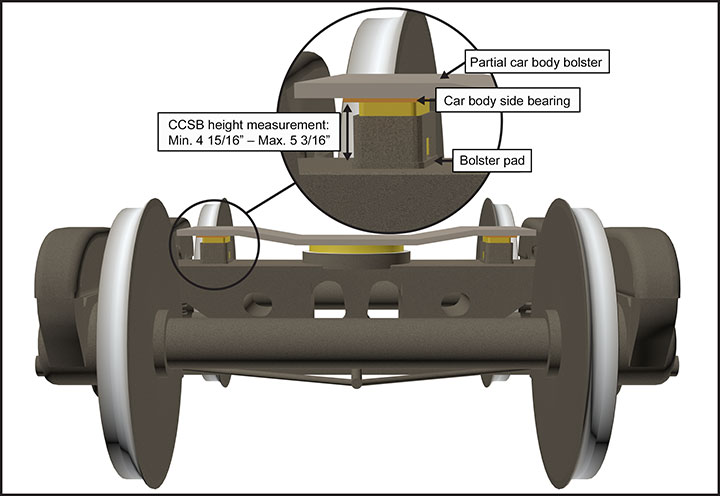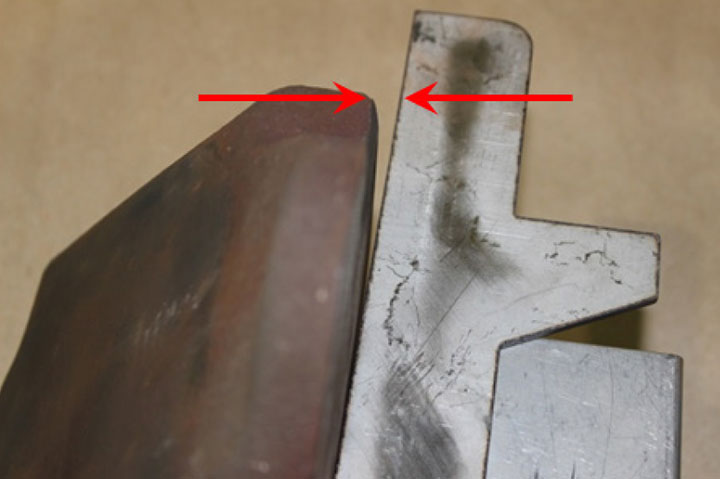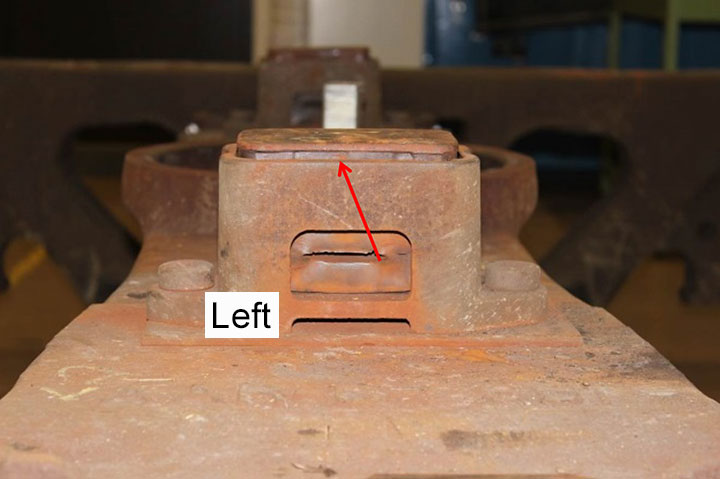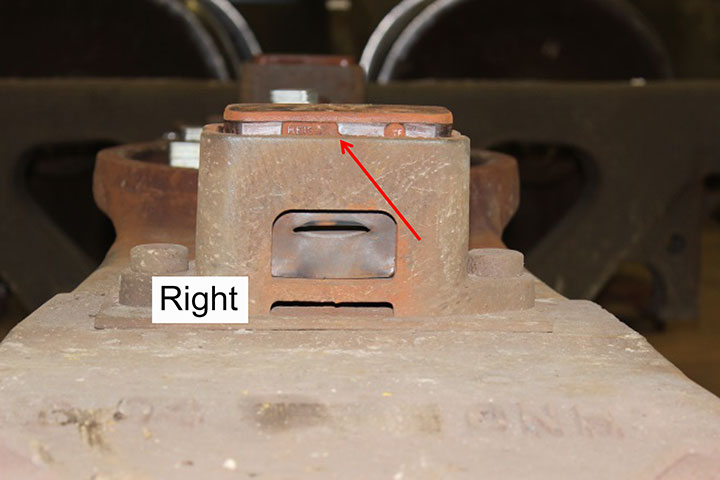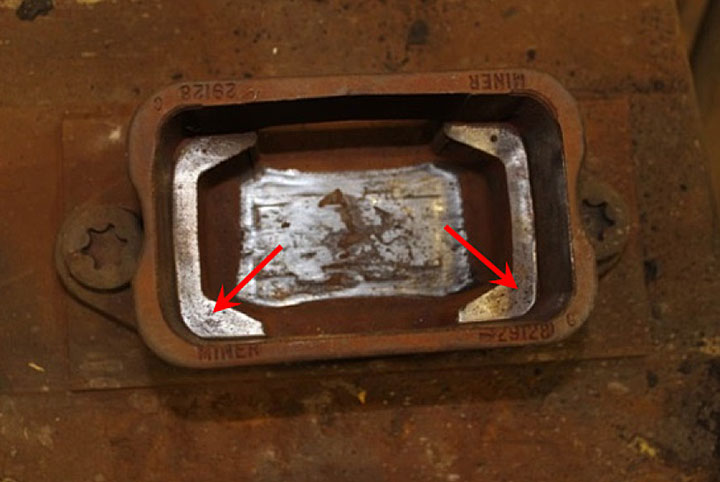Main-track train derailment and collision
Canadian National freight train M36831-01 and
VIA Rail Canada Inc. passenger train No. 47
Mile 153.92, Kingston Subdivision
Gananoque, Ontario
The Transportation Safety Board of Canada (TSB) investigated this occurrence for the purpose of advancing transportation safety. It is not the function of the Board to assign fault or determine civil or criminal liability. This report is not created for use in the context of legal, disciplinary or other proceedings. See Ownership and use of content. Masculine pronouns and position titles may be used to signify all genders to comply with the Canadian Transportation Accident Investigation and Safety Board Act (S.C. 1989, c. 3).
Summary
On 01 August 2014, at about 1412 Eastern Daylight Time, Canadian National (CN) freight train M36831-01 (CN 368) was proceeding eastward on the north main track of the CN Kingston Subdivision when it experienced a train-initiated emergency brake application and derailed at Mile 153.92. The CN crew immediately made an emergency radio broadcast as the train slowed. At about the same time, VIA Rail Canada Inc. (VIA) passenger train No. 47 (VIA 47) was proceeding westward on the south main track when its crew observed that CN 368 was derailed. Upon hearing the emergency radio broadcast, the VIA crew initiated an emergency brake application. As the 2 trains were slowing to a stop, a derailed centre beam bulkhead flat car struck VIA 47’s lead locomotive and then scraped along the north side of the 5 VIA coaches. The tail-end 6 cars on CN 368 derailed and were damaged. As a result, the front of the VIA locomotive and the north side of the VIA coaches sustained impact damage. The fuel tank on the VIA locomotive was punctured and released about 1000 litres of diesel fuel. There were no injuries.
Factual information
On 01 August 2014, at about 0850,Footnote 1 Canadian National (CN) freight train M36831-01 (CN 368) departed Macmillan Yard in Toronto, Ontario, travelling eastward on the CN Kingston Subdivision, destined for Montréal, Quebec (Figure 1). The train consisted of 2 head-end locomotives, 52 loaded cars (with 7 cars containing dangerous goods), 62 empty cars, and 6 residue tank cars. It was about 7680 feet long and weighed 8830 tons. Prior to departure, the train received an inspection from a certified car inspector. Upon departing Macmillan Yard, the train received a pull-by inspection.
CN 368 changed crews at Belleville, Ontario, located at Mile 219.5 of the Kingston Subdivision. The new crew consisted of a conductor and a locomotive engineer. The new crew members were qualified for their respective positions, were familiar with the territory and met established rest and fitness requirements. At about 1240, CN 368 received a pull-by inspection as it departed Belleville.
At about 1230, westbound VIA Rail Canada Inc. (VIA) passenger train No. 47 (VIA 47) departed Ottawa, Ontario, on the VIA Smiths Falls Subdivision, destined for Toronto. VIA 47 consisted of 1 head-end locomotive (VIA 6424) and 5 coaches. The train was about 485 feet long and weighed approximately 355 tons. The crew was composed of a locomotive engineer, who operated the train, and an in-charge locomotive engineer, who performed the duties of a conductor. The train was staffed with 1 on-board service manager and 4 service personnel. There were 239 passengers on board.
1.1 The accident
Prior to the accident, the journey for each train had been uneventful. At approximately 1415, while proceeding eastward at about 53 mph on the north main track of the CN Kingston Subdivision, CN 368 activated the alarm of the dragging equipment detector at Mile 151.64, just east of Gananoque, Ontario. As the CN 368 crew slowed the train, an undesired emergency brake application occurred. Emergency procedures were followed and the crew immediately made an emergency radio broadcast.
At about the same time, VIA 47 was proceeding westward at 92 mph on the south main track. While passing CN 368, the VIA 47 crew heard the alarm broadcast from the dragging equipment detector and immediately initiated a minimum service brake application. The crew then observed dust rising from the track ahead and initiated a full service brake application. A few seconds later, the VIA 47 crew heard the emergency radio broadcast from the CN 368 crew. The VIA 47 crew then immediately initiated an emergency brake application.
At 1415:59, with westbound VIA 47 travelling at 51 mph and eastbound CN 368 travelling at 11 mph, the A-end of the 6th car from the tail end of CN 368 (empty centre beam bulkhead flat car GTW 623373), which was derailed and foul of the south main track, struck the front of the VIA 47 locomotive. The derailed car then scraped along the north side of the locomotive and along the north side of the 5 VIA coaches. VIA 47 did not derail. There were no injuries to the VIA crew or passengers, and no injuries to the CN crew.
At the time of the accident, the temperature was 22°C, the skies were clear, the visibility was good, and the terrain in the vicinity of the accident was generally dry.
1.2 Site examination
VIA 47 had been brought to a stop with the head-end of the train at about Mile 151.13. The north side of the VIA locomotive (Photo 1) and of all 5 coaches were damaged. The fuel tank on the VIA locomotive was punctured about halfway up its leading corner and about 1000 litres of diesel fuel had been released.
The head end of CN 368 came to rest at Mile 149.53. The tail end 6 cars of CN 368 had derailed.
1.2.1 Rolling stock examination
A site examination of the derailed rolling stock from CN 368 (Figure 2) revealed that:
- The 6th car from the tail end (GTW 623373) had remained attached to CN 368 and came to rest at about Mile 150.96. The leading B-end truck was not derailed.
- The trailing A-end truck had all wheels derailed to the south fouling the south main track. The A-end wheel treads exhibited heavy damage that was consistent with derailment damage sustained while travelling on the ballast of the track road bed. The top of the A-end bulkhead and the south side of the car body exhibited impact damage.
- Rub marks were visible on the car body side bearings which normally contact the corresponding truck's constant contact side bearings (CCSB).
- The 5 tail-end cars had separated from CN 368 and came to rest upright, on and just west of the Cliffe Road crossing at Mile 151.26.
- The leading truck of the 5th car from the tail end (WC 38253), an empty centre beam bulkhead flat car, came to rest on the north track on the west side of the crossing. All 8 of the car wheels had remained on the rail, but were displaying moderate damage that was consistent with derailment damage sustained while travelling on the ballast of the track road bed.
- The wheel treads of the leading truck of the 4th car from the tail end (CN 598296), an empty boxcar, had remained on the rail but were displaying light wheel tread damage. The trailing truck was derailed to the north side.
- The 3rd and 2nd cars from the tail end (empty box cars) were derailed and were leaning to the north.
- The tail end car (CGTX 23223), a Class 111 tank car loaded with lube oil, a non-regulated product (i.e. not classified as dangerous goods), came to rest upright on the south track with all wheels derailed at about Mile 151.30.
The truck assemblies and corresponding car body bolsters from car GTW 623373 (6th car from the tail end) and car WC 38253 (5th car from the tail end) were forwarded to the Transportation Safety Board of Canada (TSB) Engineering Laboratory for further examination.
1.2.2 Track infrastructure examination
Between the Cliffe Road crossing (Mile 151.26) and a main track crossover, located about 300 feet west of the crossing, the track was damaged, with wheel impact marks to the ties, tie plates, fasteners, and anchors. In some sections, the track was destroyed. Wheel flange marks were also present at the frog positioned at the switch about 300 feet west of the crossing.
The first derailment marks on the north main track were located at about Mile 153.92. (Figure 3). Wheel flange marks were present on the gauge side of the running surface on the south rail head. The marks continued eastward along the running surface toward the field side for about 32 feet, where the marks fell off to the field side. From there, the marks continued eastward for about 60 feet on the base of the rail, on the tie plates and on the ties, before impacting the planks of the private crossing at Mile 153.9. Corresponding wheel flange marks were also present on the ties between the rails. Intermittent track damage continued eastward beyond the private crossing up to the main track crossover at Mile 151.45.
Track measurements, including unloadedFootnote 2 gaugeFootnote 3 and cross-level measurements, were taken starting at the location of the wheel flange mark on the head of the south rail of the north main track, extending toward the west at 15 ½-foot intervals (Table 1).
The track measurements indicate that there were multiple minor (non-condemnable) track cross-level perturbations, ranging from 1⁄16 inch to ¾ inchFootnote 4 in the section of track located between 31 feet to 93 feet west of the first mark on the rail head. A number of minor (non-condemnable) gauge track variances, both narrow and wide gauge, were present between 15½ feet and 155 feet west of the first mark on the rail head.
| Measurement location (feet west of wheel flange mark on the rail head) | Gauge * (inches) | Cross-level (inches) |
|---|---|---|
| First wheel flange mark | 56 ½ | 0 |
| 15 ½ | 56 5⁄8 | 0 |
| 31 | 56 5⁄8 | −1⁄16 |
| 46 ½ | 56 ½ | −5⁄8 |
| 62 | 56 ½ | −¾ |
| 77 ½ | 56 ½ | −¼ |
| 93 | 56 ½ | −1⁄16 |
| 108 ½ | 56 ½ | 0 |
| 124 | 56 3⁄8 | 0 |
| 139 ½ | 56 9⁄16 | 0 |
| 155 | 56 9⁄16 | 0 |
| 186 | 56 ½ | 1⁄8 |
| 201 ½ | 56 ½ | 0 |
| * Gauge is measured between the heads of the rails at right angles to the rails in a plane 5⁄8 inch below the top of the rail head. Standard rail gauge is 56 ½ inches. | ||
1.3 Recorded information
The data from the locomotive event recorders (LER) for CN 368 and VIA 47 as well as the video recording from the forward-facing video recorder on the VIA 47 locomotive were reviewed.Footnote 5
With regards to CN 368, it was determined that:
- For the 8 minutes prior to the derailment, CN 368 was being operated at speeds between 50 and 60 mph with the brakes released and the throttle in position 8.
- At 1415:24, while the train was travelling at 51 mph, the throttle was placed in idle.
- At 1415:26, CN 368 experienced an undesired emergency brake application when the head end of the train was at Mile 149.83.
- At 1415:59, CN 368 had slowed to 11 mph when GTW 623373 (the 6th car from the tail end) struck VIA 47.
- At 1416:08, the head end of CN 368 came to rest at Mile 149.53.
With regards to VIA 47, it was determined that:
- As VIA 47 approached Gananoque from the east, it was being operated at a speed of 93 mph.
- At 1415:15, while the train was travelling at about 92 mph, a minimum service brake application was initiated.
- At 1415:42, while travelling at about 78 mph, a full service brake application was initiated.
- At 1415:52, while travelling at about 64 mph, an emergency brake application was initiated.
- At 1415:59, while travelling at about 51 mph, VIA 47 locomotive was struck by car GTW 623373.
- At 1416:24, VIA 47 came to rest.
1.4 Subdivision and track information
CN's Kingston Subdivision extends westward from Mile 10.3 (Dorval East, Quebec) to Mile 333.8 (Toronto). Train movements are governed by Centralized Traffic Control, as authorized by the Canadian Rail Operating Rules, and supervised by a rail traffic controller (RTC) located in Toronto. The track is Class 5 according to the Transport Canada (TC)-approved Rules Respecting Track Safety, also known as the Track Safety Rules (TSR). The authorized speed is 65 mph for freight trains and 95 mph for passenger trains. Train traffic on the Kingston Subdivision consists of about 20 freight trains and 19 passenger trains daily.
In the vicinity of the derailment, the subdivision consists of 2 tangent main tracks, oriented in an east-west direction. Two main-track crossovers were located at Mile 151.45, just west of the Cliffe Road crossing. The north track consisted of 132-pound continuous welded rail (CWR) manufactured in 1984. The rail was laid on 14-inch double-shoulder tie plates and supported by number 1 hardwood ties with 8 spikes per tie and box-anchored every second tie. The ballast was crushed rock. The shoulders were about 24 inches wide and the cribs were full.
On 13 October 2012, a bonded insulated joint on the south rail of the north track at Mile 153.92 was repaired by installing a short section of rail. Consequently, 3 joint bars were present at this location, positioned about 8 feet to 27 feet west of the 1st impact marks on the track.
Track inspections had been performed regularly in accordance with the TSR. The most recent visual inspection had been completed on 29 July 2014. The most recent track geometry car inspection had been completed on 04 June 2014. During this inspection, an urgent cross-level defect and a near-urgent cross-level defect were noted near Mile 153.93. At this location, the track surface was restored on 06 June 2014.
1.5 Centre beam bulkhead flat car GTW 623373
CN has a fleet of approximately 8000 centre beam bulkhead and standard bulkhead flat cars.Footnote 6 Car GTW 623373 is one of 489 GTW centre beam bulkhead flat cars in CN's fleet built between 1994 and 1998.
Centre beam bulkhead flat cars are approximately 80 feet long and relatively light when empty (Photo 2). This car type is designed with a bulkhead at each end to prevent loads from shifting and a centre beam integrated into the car centre sill to secure loads. This car type is less torsionally rigid than other types of cars, and is known to be more susceptible to truck hunting when empty.
Car GTW 623373 was equipped with standard Barber S2 trucks that had Miner standard travel (ST) CCSBs installed. This type of CCSB is composed of 1 resilient member, a metal cap and a cage (Figure 4).
Car repair records indicate that on 24 October 2006, another railway replaced worn A-end friction castings. There is no indication that the CCSB components were inspected or replaced at that time.
1.6 Truck hunting
Truck hunting is the oscillation of the wheel set from rail to rail due to the dynamic response of the railway car truck as it travels along the track. All wheel sets hunt as they seek to achieve the optimal placement of the wheel tread conical taper on the rails. Under certain conditions, truck hunting can become excessive resulting in hard contact between the wheel flange and the rail head, in wheel lift, and in some cases, derailment.
Truck hunting will typically become more severe when lightly loaded or empty cars, greater than 50 feet in length, travel at speeds in excess of 45 mph on dry tangent CWR track. Throughout North America, there are about 48 000 bulkhead and centre beam bulkhead flat cars, which are known to be more susceptible to truck hunting when empty.
In addition, excessive truck hunting can be more pronounced in trucks with low warp stiffness. Certain older truck designs, such as the Barber S2, have low warp stiffness and are known to be prone to excessive hunting. While truck component and wheel wear can exacerbate the phenomenon, excessive truck hunting can also occur on cars with these components in good condition.
The presence of certain track conditions in close proximity to each other, such as narrow gauge and multiple minor track cross-level perturbations, are also known to initiate excessive truck hunting. While truck hunting is more likely to occur in track with narrow gauge, it can be more severe in track with wide gauge. However, excessive truck hunting can also occur on track in good condition.
Truck hunting can cause car body lateral oscillation. The side-to-side motion of the truck as it hunts causes the car body ends to rotate about their centre of gravity. As both trucks do not hunt in unison, a torsional force along the length of the car can develop. The torsional force will load and unload in a spring-like manner. Certain cars, such as the centre beam bulkhead flat car with a torsionally flexible car body and large bulkheads at each end, have increased susceptibility to this spring-like loading. This torsional force can contribute to wheel offloading. In extreme cases, truck hunting and wheel offloading can cause the wheel flange to climb the gauge face of the rail, derailing the truck. Low spots in the rail, narrow gauge, and a lateral force caused by dynamicFootnote 7 braking can also contribute to a wheel climb event.Footnote 8 When a truck hunting-type derailment occurs, long flange marks may be present along the running surface of the rail.
Over the years, the railway industry has become more aware of the truck hunting phenomenon. Since the 1990s, to address the tendency for trucks to hunt excessively at high speeds, railway cars have been built with CCSBs installed. The first type of CCSBs installed were the ST CCSBs.
In 2002, the Association of American Railroads (AAR) Manual of Standards and Recommended Practices (MSRP) adopted Specification M-976 (Truck Performance for Rail Cars) which introduced improved truck performance requirements. Specification M-976 included testing requirements for the control of truck hunting and placed limits on the allowable lateral acceleration of the trucks. Freight car trucks built to this standard have improved warp stiffness and are less susceptible to excessive truck hunting.
In 2003, new freight cars were required to be equipped with the newly developed long travel (LT) CCSBs, which provides more effective damping and further reduces the risk of excessive truck hunting. Because of this superior performance, Rule 88 in the AAR Office Manual was revised to indicate that, as of 01 January 2003, certain cars be equipped with LT CCSBs, including all new, rebuilt or modified cars, and all cars that have been given an increased gross rail load, an extended service, or increased life status.Footnote 9
In 2006, the AAR Interchange Rules were further modified to protect against wheel lift derailments due to truck twist and truck hunting. The requirement was added for LT CCSBs to be installed when converting cars from roller or block side bearings. Cars with ST CCSBs installed were not affected. The 2006 modification also prohibited the use of roller or block side bearings on bulkhead flat cars and centre beam bulkhead flat cars as of 01 January 2011.
1.7 Constant contact side bearings
CCSBs are secured to the truck bolster below the car body side bearing,Footnote 10 which is secured to the underside of the car. The CCSB cap serves as the bearing surface upon which the car body side bearing is in constant contact. Resilient members beneath the cap provide the vertical force (preload) to keep the cap in constant contact with the car body side bearing. The CCSB cap displaces vertically to allow the car body to roll relative to the truck. CCSBs increase the truck's turning resistance by placing a load between the truck and the car body side bearing thereby minimizing truck hunting. CCSBs also limit the side-to-side oscillation of the car body.Footnote 11
A known problem with CCSB arrangements is designing a resilient member with characteristics suitable for the long-term loads and stresses encountered during operation of the rail car. Resilient members are susceptible to thermal damage from the heat generated at the interface between the bearing cap and the car body side bearing. Worn, melted or deformed resilient members lessen the preload, lowering the rotational resistance of the truck.Footnote 12 A 2014 Transportation Technology Center, Inc. (TTCI) study for CN concluded that “decreasing side bearing preload for ST CCSBs was also shown to increase derailment risk due to vertical wheel unloading in track with cross-level perturbations.”
The installation of LT CCSBs enables the wheels to remain in contact with the rail longer thus lowering the risk of derailment. LT CCSBs allow for improved curve negotiation and better negotiation of track irregularities.Footnote 13 In contrast, ST CCSBs are more prone to bottoming out and introducing wheel offloading forces into the truck during excessive truck hunting events. A 2006 TTCI studyFootnote 14 concluded that LT CCSBs improve rail operations by “maintaining better vertical wheel loads, providing high-speed stability, and providing more predictable truck turning forces.”
In addition, the improved design of the resilient member and the CCSB has resulted in LT CCSBs being less susceptible to the negative effects of wear.
1.8 Requirements for visual train inspections
The TC-approved Railway Freight Car Inspection and Safety Rules (Freight Car Safety Rules) require that all cars receive a visual safety inspection performed by a certified car inspector at, among other locations, the location where trains are made up. At locations where a certified car inspector is not on duty, the safety inspection is to be performed at the designated safety inspection location en route.
To comply with the Freight Car Safety Rules, CN provides instructional material to the certified car inspectors on how to visually inspect a train. As part of these inspections, inspectors are instructed to ensure that all CCSB components are in place, are in good condition, and are not loose, bent, broken, or missing. The car inspector should also look for contact between the CCSB and the car body side bearing. However, visual inspections cannot assess the preload force supplied by the CCSBs. As such, a CCSB can be in contact with the car body side bearing without providing effective support. The Freight Car Safety Rules require that cars be taken out of service when more than one CCSB is not making contact with the body side bearing.Footnote 15
A 2007 study relating to the inspection and maintenance processes for CCSBsFootnote 16 indicated that even in situations where the metal cap is in contact with the car body side bearing, visual observation has proven to be unreliable in evaluating the preload force. The study further indicated that “some components and assemblies should be replaced or repaired even though individually, they may not be condemnable according to present standards and rules.”
1.9 Association of American Railroads constant contact side bearing repair requirements
When repairing railway equipment, railways are guided by the Field Manual of the AAR Interchange Rules (Interchange Rules). In 2006, Rule 62 B.5 of the Interchange Rules pertaining to truck side bearings required the replacement of the CCSB's resilient members:
whenever trucks are repaired on account of either friction castings, gibs, or friction pockets having reached condemning limits as outlined in Rule 47.
Rule 47 stipulates the conditions and wear limits for truck bolster that are cause for renewal.
In 2014, the Interchange Rules (2014) relating to truck side bearings were revised. Rule 62 B.5 now requires that the resilient member be replaced:
on any truck(s) which receive repairs per the following rules:
- Friction castings (Rule 46 as applies when truck detected by hunting or truck performance detector)
- Bolster Gibs (Rule 47)
- Friction Pockets (Rule 47)
Rule 46 A.1.e details the condemning limits for trucks evaluated by a truck hunting detector (THD).
The 2014 rules do not require the replacement of the resilient member when the friction castings are replaced. However, the resilient member must be replaced when the truck is identified as condemnable by a THD.
The 2014 Interchange Rules further indicate that:
- CCSBs are condemnable at any time should the resilient member be missing or exhibit heat damage (Rule 62 A 1.d), or should the sum-of-pairs height measurementFootnote 17 be less than 9¾ inches or greater than 10½ inches (Rule 62 A 1.h. (1)).
- CCSBs are condemnable when the car is on a shop or repair track should the resilient member exhibit damage (Rule 62 A 2.b),Footnote 18 or should the height for a single CCSB be less than 415⁄16 inches or greater than 53⁄16 inches (62 A 2.a(1)) (Figure 5).
- Damaged resilient members should be replaced in kind with new members.Footnote 19
1.10 Truck hunting detectors
In addition to visual inspections, to help identify cars that are hunting excessively, railways utilize THD systems installed along the track. THDs identify these cars by measuring the angle of attack of the wheelset, and the lateral and vertical forces exerted by each wheelset as the train passes a detector. Based on the THD measurement, the detector assigns a truck hunting index absolute value reading to each truck; the more severe the hunting, the higher the reading. THDs can be used to identify those trucks whose stabilizing components, including CCSBs and their resilient members, require inspection. As excessive truck hunting typically occurs when long empty freight cars are travelling at speeds greater than 45 to 50 mph, THDs are most effective under these conditions.
Rule 46 A.1.e. of the Interchange Rules (2014) indicates that a truck becomes condemnable:
- if it receives a truck hunting index absolute value that is greater than (or equal to) 0.50, or
- if it receives 2 truck hunting index absolute values that are greater than (or equal to) 0.35 within a 12-month period.
In both of these situations, the car must be taken to a repair facility and the truck must be repaired or replaced. Car owners must also be informed when a truck receives a truck hunting index absolute value that is greater than (or equal to) 0.20, to allow the car owner to act upon any potential problems.
As cars can be interchanged between railways (i.e., operate on another railway's track), the AAR developed the Railinc Equipment Health Management System (EHMS), which is a centralized database system to notify car owners and operators of alerts assigned to their cars. This includes alerts identified by THDs from another railway. In 2014, there were about 80 THDs installed on the railway network throughout North America. CN subscribed to the EHMS service and was receiving these alerts.
At CN, THDs are integrated into wheel impact load detector (WILD) sites, where truck hunting conditions were assumed to be more prevalent (e.g., tangent track where speeds were greater than 50 mph). At the time of the derailment, CN had 1 Double Track THD site with 2 detectors installed on its Canadian railway network. This THD was installed at Mile 29.2 on the Kingston Subdivision, at Les Cèdres, Quebec, approximately 88 miles east of the derailment location. Since the accident, 3 additional WILD locations have been upgraded with a THD, including:
- Clarke, Ontario – Mile 290.50 of the Kingston Subdivision, 1 detector installed on each of its 2 tracks;
- Shonts, Alberta – Mile 219.00 of the Wainwright Subdivision; and
- Ste. Anne, Manitoba – Mile 127.00 of the Sprague Subdivision.
All THDs were programmed to provide immediate alerts to the rail traffic control mechanical service representative when "hunting index" readings were greater than 0.35, so that speed restrictions could be applied.
A review of the EHMS data determined that car GTW 623373 had travelled over 9 THDs between August 2013 and July 2014. On 4 of these occasions, the car was empty, and the highest truck hunting index absolute value recorded for the A-end was 0.21 on CSX Transportation Railway on 01 July 2014 (Appendix A). The most recent truck hunting index absolute value recorded for the A-end was 0.148 on CN on 04 July 2014 while the car was empty.
1.11 Canadian National's retrofit program for long travel constant contact side bearings
In 2005, to comply with the AAR mandated program to retrofit flat cars with LT CCSBs by 2011, CN began retrofitting all its cars entering its Transcona maintenance facility with LT CCSBs, except for those already equipped with ST CCSBs. In 2010, the retrofit program was expanded to encompass additional maintenance facilities across the CN network.
1.12 Performance-based track geometry monitoring systems
In 2004, the Burlington Northern Santa Fe (BNSF) Railway and the TTCI conducted a study in the United States on performance-based track geometry (PBTG) inspection technologyFootnote 20 PBTG inspection technologies are used to relate track geometry conditions to vehicle performance data facilitating the identification of track segments with poor predicted vehicle performance, such as excessive truck hunting. Using this information, maintenance activities can be implemented to reduce derailment potential.
A 2009 TTCI paper entitled “Latest Development in Performance-based Track Inspection Technologies” describes 2 types of PBTG systems:
The first system outfits railway cars with sensors to measure a vehicle's response to actual track conditions. The data was assessed in real-time for track geometry conditions and recommendations for maintenance actions are made.
The second system works as an add-on to conventional track geometry inspection vehicles. Track geometry data and vehicle operating data are input into the PBTG system. Real time vehicle performance analysis is carried out and track segments with predicted vehicle response values beyond pre-determined limits are identified, and a list of recommended maintenance actions is generated. At the time of the publication of the paper, the system was in use on several North American railways. While the PBTG system identified potential problem areas, the anomalies did not fall within the United States Department of Transportation Federal Railroad Administration's definition of a defect.
1.13 TSB laboratory examination of GTW 623373 and WC 38253
The truck assemblies and corresponding car body bolsters from centre beam bulkhead flat cars GTW 623373 and WC 38253 were sent to the TSB Engineering Laboratory.
GTW 623373 (6th car from the tail end) was built in 994. The car was equipped with Barber S-2 truck assemblies fitted with ST CCSBs. The Barber S-2 truck, also manufactured in 1994, did not meet the AAR MSRP M-976 specification, which was developed for new cars built after 2002. Barber S-2 trucks have reduced warp resistance and are known to be susceptible to truck hunting.
WC 38253 (5th car from the tail end) was built in 2005. The car was equipped with Barber S-2 HD truck assemblies fitted with LT CCSBs. The Barber S-2 HD truck meets the AAR M-976 specification and has improved warp resistance, making it less susceptible to truck hunting.
During the derailment, the trailing A-end truck from GTW 623373 and both trucks from WC 38253 sustained significant damage, and these trucks were missing components. The leading (B-end) truck from GTW 623373, which did not derail, remained intact. Consequently, only the B-end truck from GTW 623373 and corresponding car body bolster were available for detailed examination.
During this examination, it was noted that:
- Both friction wedge castings were worn to a convex shape while the corresponding truck side column wear plates mating surfaces were worn to a concave shape. This wear pattern suggests that the truck had reduced warp resistance (Photo 3).
- The elastomer element of the B-end left side (BL) CCSB was permanently deformed and was likely past its service life. The height range indicator was not visible (Photo 4).
- For the elastomer element of the B-end right side (BR), the height range indicator was visible (Photo 5).
- Wear observed on the CCSBs, their cages, and the corresponding body side bearings was consistent with wear observed on trucks with CCSBs that have lost their dampening characteristics. In particular, the lugs of the CCSB cage were polished, indicating that the CCSB had bottomed out (Photo 6).
- The height of the side bearings of the subject truck assembly was measured between the bolster pad and the side bearing contact plate. The measured heights on the left and right sides were 4 5/⁄8 inches and 5 inches respectively, giving a total value of 9 5/⁄8 inches, which is 1/⁄8 inch below the AAR condemning limit.
The examination concluded that the loss of damping, as well as the wear in the friction castings, is indicative of a truck that has reduced stiffness and was likely susceptible to excessive hunting.
1.14 Other TSB occurrences involving excessive truck hunting
In 1991, the TSB investigated an 11-car derailment that occurred near Coteau, QuebecFootnote 21. The investigation determined that severe truck hunting, de-synchronization of the car body, and truck oscillation while traversing over a low section of rail were factors that contributed to the derailment. As a result, the Board made the following 2 recommendations:
The Department of Transport ensure that appropriate speed restrictions are in effect for all empty bulkhead flat cars and long gondola cars which are not equipped with constant contact side bearings.
Transportation Safety Recommendation R93-08
The Department of Transport assesses the requirement for speed restrictions on other rail car types to reduce the likelihood of derailments related to truck hunting.
Transportation Safety Recommendation R93-09
Following the recommendations, CN and Canadian Pacific (CP) applied speed restrictions (50 mph) to trains with bulkhead flat cars and open top gondola cars in their consists. In December 1997, the TSB assessed the response to Recommendation R93-08 to be Fully Satisfactory. In May 2005, after additional speed restrictions were placed on hopper cars and ore cars, the response to Recommendation R93-09 was assessed to be Fully Satisfactory.
In addition, the Transportation Development Centre, in conjunction with industry suppliers and the railways, conducted research into freight car truck performance, and into the development of a freight car truck with improved high-speed performance characteristics. The prototype was tested in Canada, and submitted for further testing and development at the AAR test facilities in Pueblo, Colorado.
Following a 1996 derailment involving truck huntingFootnote 22, the TSB issued Rail Safety Advisory 04/96. The Rail Safety Advisory indicated that considering that truck hunting is associated with high speeds and therefore poses a greater risk of consequences in the event of a derailment, TC may wish to review operating restrictions (speed) on all empty open top gondola cars as they relate to truck hunting. TC responded that CN and CP were imposing further speed restrictions on additional types of cars identified as susceptible to truck hunting and that the AAR was continuing its research work on new truck designs and CCSBs.
The TSB conducted investigations into other derailments involving truck hunting, including R95W0117, R96H0021 and R04Q0006. Each of these derailments were attributed to truck hunting-induced wheel climb/lift involving empty cars travelling at speeds near or greater than 50 mph, some with truck wear and some encountering track perturbations.
As part of TSB's investigation into the 2004 derailment on the Montmagny SubdivisionFootnote 23 in Montmagny, Quebec, a high-speed stability study using NUCARSFootnote 24 was conducted by the National Research Council of Canada. While the study was concentrated on truck hunting by empty gondola cars, it confirmed the relationship between excessive truck hunting, poor truck maintenance resulting in reduced truck warp resistance, and car speeds in excess of 45 mph. The TSB Engineering Laboratory also examined the effect of dynamic braking on truck hunting and wheel lift. It was determined that limited dynamic braking had only a minimal effect on the truck hunting performance of a car. However, dynamic braking can increase the risk of wheel climb or of a wheel shift when a wheel is already unloaded, leading to derailment.Footnote 25
More recently, the TSB investigated a CN derailment which occurred on 10 July 2014 on the Kingston SubdivisionFootnote 26 involving an eastward freight train that derailed 26 cars while approaching Brockville, Ontario (Mile 127.53). An empty centre beam bulkhead flat car, built in 1994, whose ST CCSBs were not providing the expected damping force, was the first car to derail as a result of excessive truck hunting. The investigation determined that development of excessive truck hunting was likely influenced by the type of car, the speed of the train, the worn condition of the A-end CCSBs, a truck type with low warp stiffness, and non-condemnable, slightly narrow gauge and multiple cross-level perturbations in the south rail.
1.15 TSB laboratory reports
The TSB completed the following laboratory report in support of this investigation:
- LP163/2014 – Examination of Flat Car Trucks
2.0 Analysis
The train was operated in accordance with company and regulatory requirements. The analysis will focus on the condition of the rolling stock, factors that were present that could initiate excessive truck hunting, inspection of constant contact side bearings (CCSB), and the effectiveness of truck hunting detectors (THD).
2.1 The accident
The accident occurred when the A-end truck of GTW 623373, the 6th car from the tail end of Canadian National (CN) freight train M36831-01 (CN 368), derailed at Mile 153.92 of the CN Kingston Subdivision. GTW 623373 was an empty 80-foot long centre beam bulkhead flat car, a car type known to be susceptible to truck hunting. Long wheel flange marks on the running surface of the rail at Mile 153.92 were the first marks on the track. Following these marks, flange marks were present on the track ties, fasteners and crossing planks extending eastward on the north main track.
From Mile 153.92, the intermittent track damage extending eastward was consistent with damage expected from a derailed freight car truck. The derailed truck activated the dragging equipment detector at Mile 151.64. When the derailed truck contacted the main track crossover at Mile 151.45, the 5 trailing cars derailed and separated from CN 368. These 5 cars separated from the train at the Cliffe Road crossing (Mile 151.26), initiating an emergency brake application on CN 368. The CN 368 crew then immediately made an emergency radio broadcast to alert traffic in the area. As the train slowed on the north track, GTW 623373 remained connected to CN 368 with its trailing A-end derailed and foul of the south track.
At about the same time, VIA Rail Canada Inc. (VIA) passenger train No. 47 (VIA 47) was proceeding westward at 92 mph on the south main track when the VIA 47 crew heard the dragging equipment detector alarm broadcast and initiated a minimum service brake application. Upon observing dust rising from the track ahead, the VIA 47 crew initiated a full service brake application. Shortly thereafter, the VIA 47 crew heard the emergency radio broadcast and initiated an emergency brake application. With VIA 47 slowed to 51 mph and CN 368 slowed to 11 mph, the trailing A-end of GTW 623373 struck the front of the VIA 47 locomotive and scraped along the north side of the locomotive and the 5 VIA coaches.
In this occurrence, the dragging equipment detector and related alerting systems and procedures, which were designed to inform train crews of the derailed condition of a train, worked as intended. The train crews of both CN 368 and VIA 47 took prompt action when made aware of the derailed condition of CN 368 and, consequently, a more serious accident with the potential for much greater damage and injuries was avoided.
2.2 Truck hunting
The long wheel flange marks on the top of rail at the point of derailment (POD) were indicative of a wheel climb or wheel lift event. This, together with the type of cars involved in the derailment, the tangent characteristic of continuous welded rail (CWR) track, the train speed, the dry rail condition in the presence of non-condemnable track perturbations, points to a derailment involving excessive truck hunting.
Many of the conditions that are known to initiate excessive truck hunting were present in this occurrence. Empty cars (i.e. light) in excess of 50 feet in length, designed with low torsional rigidity and equipped with low warp resistance trucks, were being operated at a speed of 53 mph on dry tangent CWR track.
Within the 155-foot section of track in advance of the POD, there was a slightly narrow gauge condition located approximately 124 feet west of the POD. From that point eastward, unloaded gauge and cross-level track measurements leading up to the POD identified a number of track anomalies and an area of slightly wider gauge, which individually were not condemnable, but in combination were known to induce excessive truck hunting. The A-end truck of GTW 623373 began to hunt excessively, which in turn exacerbated the natural car body oscillation. This condition is known to initiate wheel offloading and can lead to wheel climb or wheel lift events. As freight car GTW 623373 passed over the track anomalies immediately preceding the POD, the A-end truck began to hunt excessively at a time when the car was offloading due to car body oscillation, resulting in a wheel lift/climb event.
The trucks of the 5th derailed car from the tail end (WC 38253) were manufactured in 2005 to Association of American Railroads' AAR MSRP M-976 specifications and equipped with long travel (LT) CCSBs, features which are known to have improved truck damping and warp resistance making them less susceptible to truck hunting. In contrast, GTW 623373 was equipped with trucks that were manufactured in 1994 and did not meet AAR MSRP M-976 specifications which were issued 8 years after it was built. Trucks equipped with standard travel (ST) CCSBs (as was the case for GTW 623373) typically have reduced damping and warp resistance and are known to be susceptible to excessive truck hunting. In addition, the wheel treads of GTW 623373 exhibited the heaviest derailment damage of any of the derailed cars, which indicated that they had been in contact with the track road bed for the longest period of time.
The GTW 623373 B-end left side (BL) CCSB was past its condemning limit, which indicates that it had lost its preload and was no longer providing effective damping. The worn condition of the leading B-end truck friction wedge castings indicated that the truck's warp resistance was even further reduced. Because the trucks were both installed new in 1994 and were subject to the same operating conditions while in service, it is likely that the conditions observed in the leading B-end truck were also present in the trailing A-end truck which derailed. The A-end truck of empty centre beam flat car GTW 623373 was the first truck to derail as a result of excessive truck hunting. Given the circumstances, it is most likely that the excessive truck hunting on car GTW 623373 was influenced by the type of car, the speed of the train, and the worn condition of the A-end truck, which further reduced the warp resistance in a truck type that is known to be susceptible to excessive truck hunting.
2.3 Constant contact side bearings
CCSBs are installed to reduce truck hunting forces as rail cars travel at high speeds. For the CCSBs to remain effective, they have to be maintained.
In 2006, the friction wedge castings on the trucks from car GTW 623373 were repaired by another railway. The AAR Interchange Rules at that time required that the CCSB's resilient member be replaced as part of the repair. Although records indicate that the friction wedge castings were replaced, there is no indication that the resilient members were replaced. Consequently, an opportunity to restore the CCSBs resilient members was missed when they were not replaced during a related repair at a foreign railway. Allowed to continue in service, the resilient members deteriorated to the point where they likely no longer provided effective damping.
The investigation into the 2014 derailment at Brockville, Ontario,Footnote 27 also involved a CN centre beam bulkhead flat car, built in 1994, whose ST CCSBs were not providing adequate damping force. Similar to this occurrence, mandatory replacement of the car's resilient member during replacement of its friction wedge castings in 2007 did not occur as required at the time the repair was made.
The first derailed car in this occurrence and in the Brockville derailment had been built before 2003. Bulkhead flat cars and centre beam bulkhead flat cars built before 2003 came equipped with roller or block type side bearings or ST CCSBs. The railway industry has introduced rules targeted at removing roller or block type side bearings from these types of cars. As well, it has required side bearings of all types to be upgraded to LT CCSBs when cars are rebuilt, modified, given an increased gross rail load status, an extended service status or an increased life status.
With about 8000 centre beam bulkhead flat cars and standard bulkhead flat cars in CN's fleet, and about 48 000 cars throughout North America, other cars of this type equipped with ST CCSBs may not be providing sufficient damping force.
Railways continue to monitor their fleet of cars while in service to ensure that the truck components, including the CCSBs, are not worn to an extent that they no longer perform as intended. Visual inspections, performed by certified car inspectors, are effective in identifying damaged or broken CCSBs on in-service cars, leading to repairs. However, these inspections cannot evaluate the force exerted by the CCSBs against the car body to ensure that they are effective. If inspection programs do not identify CCSBs with inadequate preload force and ineffective damping, trucks that have the potential for excessive hunting will remain in service, increasing the risk of derailments due to wheel climb or wheel lift events.
2.4 Truck hunting detectors
Railways have begun to install THDs to monitor in-service cars for excessive truck hunting. As of 2014, there were about 80 such detectors throughout North America, 4 of which are on CN's track network. The implementation of this technology has been a positive safety enhancement as it has helped detect at-risk trucks which may not have been found to be condemnable through visual inspection alone. The technology, however, is most suitable and reliable when monitoring unloaded/lightly loaded cars that are travelling at speeds greater than 50 mph.
In this occurrence, the first car to derail, GTW 623373, had travelled over 9 THDs between August 2013 and July 2014. Only 4 of these evaluations had occurred with the car being empty. On each of the 9 occasions, no condemnable truck hunting index absolute values were recorded. However, the A-end and B-end CCSBs of this car were likely in a deteriorated state and were no longer providing effective damping for the car.
Since THDs evaluate the truck as a system, a single truck component (or partial group of components) that has deteriorated would be difficult to detect. As the tendency for a truck to hunt excessively can be related to the specific characteristics of the car (speed, load status, body type, truck design, and wheel profile) and the track (rail profile, track geometry, presence of precipitation), the potential for excessive truck hunting will vary from car to car and from location to location. As determined in TSB investigation R14T0160, cars with an elevated risk of excessive truck hunting may not always do so at THD locations. While THDs may not always identify cars at increased risk of excessive truck hunting, the technology does provide an additional method with which to evaluate the mechanical fitness of in-service cars and to improve safety.
2.5 Performance-based track geometry
New technologies introduced in recent years have allowed railways to improve the ride performance of their equipment by better targeting track maintenance programs. Performance-based track geometry (PBTG) inspection technologies are used to relate track geometry conditions to vehicle performance data. This facilitates the identification of track sections with poor predicted vehicle performance, including excessive truck hunting. Using this information, track maintenance activities can be targeted at specific track locations to help improve the ride performance of freight cars at these locations. Although the railway industry has implemented THDs to monitor freight car performance, the use of emerging PBTG inspection technologies may further advance safety by targeting track maintenance activities at specific locations to help improve the ride performance of freight cars.
3.0 Findings
3.1 Findings as to causes and contributing factors
- The accident occurred when the A-end truck of the 6th car from the tail-end of Canadian National (CN) freight train M36831-01 (CN 368) derailed at Mile 153.92 of the CN Kingston Subdivision. When the derailed truck contacted the main track crossover at Mile 151.45, the 5 trailing cars derailed and separated from CN 368.
- With VIA Rail Canada Inc. (VIA) passenger train No. 47 (VIA 47) slowed to 51 mph and Canadian National freight train M36831-01 slowed to 11 mph, the trailing A-end of car GTW 623373 struck the front of the VIA 47 locomotive and scraped along the north side of the locomotive and the 5 VIA coaches.
- The excessive truck hunting on car GTW 623373 was influenced by the type of car, the speed of the train, and the worn condition of the A-end truck, which further reduced the warp resistance in a truck type that was known to be susceptible to excessive truck hunting.
- An opportunity to restore the constant contact side bearing resilient members was missed when they were not replaced during a related repair at another railway. Allowed to continue in service, the resilient members likely deteriorated to the point where they no longer provided effective damping.
3.2 Findings as to risk
- If inspection programs do not identify constant contact side bearings with inadequate preload force and ineffective damping, trucks that have the potential for excessive hunting will remain in service, increasing the risk of derailments due to wheel climb or wheel lift events.
3.3 Other findings
- The dragging equipment detector and related alerting systems and procedures, which were designed to inform train crews of the derailed condition of a train, worked as intended.
- The train crews of both Canadian National freight train M36831-01 (CN 368) and VIA Rail Canada Inc. (VIA) passenger train No. 47 took prompt action when made aware of the derailed condition of CN 368 and, consequently, a more serious accident with the potential for much greater damage and injuries was avoided.
- While truck hunting detectors may not always identify cars at increased risk of excessive truck hunting, the technology does provide an additional method with which to evaluate the mechanical fitness of in-service cars and to improve safety.
- Although the railway industry has implemented truck hunting detectors to monitor freight car performance, the use of emerging performance-based track geometry inspection technologies may further advance safety by targeting track maintenance activities at specific locations to help improve the ride performance of freight cars.
4.0 Safety action
4.1 Safety action taken
4.1.1 TSB rail safety advisory 09/14
On 14 August 2014, the TSB issued Rail Safety Advisory 09/14 indicating that, given the potential consequences of excessive truck hunting, Transport Canada may wish to ensure that railways operating in Canada have appropriate measures in place to restrict train speed when the train is transporting empty centre beam bulkhead flat cars.
Both Canadian National (CN) and Canadian Pacific responded by reintroducing 45 mph speed restrictions for all empty centre beam bulkhead flat cars.
4.1.2 Canadian National
In August 2014, CN used truck hunting detector data from across North America to evaluate the risk of excessive truck hunting for different types of cars. The BCOL 730 and GTW 623 series of centre beam flat cars were identified as having the highest risk. CN undertook a program to target both series of cars for upgrade to long travel (LT) constant contact side bearings (CCSB).
As of July 2015, about 2100 cars had been upgraded, with approximately 140 remaining.
4.2 Safety concern
Many factors must normally be present before a car hunts excessively and derails. Properly installed and maintained constant contact side bearings (CCSBs) have been shown to reduce the risk of excessive truck hunting leading to derailments. The industry, aware of the role that CCSBs play in truck performance, began installing standard travel (ST) CCSBs on cars in the 1990s. However, when ST CCSBs become worn, their effectiveness decreases.
LT CCSBs provide even greater ride performance as compared to ST CCSBs, and can further lower the risk of excessive truck hunting. Consequently, since 2003 the industry has required newly built cars to be manufactured with LT CCSBs installed. For older cars equipped with ST CCSBs or roller or block type side bearings, the industry has only required that these cars be upgraded to LT CCSBs when undergoing certain modifications or repairs, leaving some cars in service without being upgraded to LT CCSBs.
Railways monitor their fleet of cars while in service to ensure that the truck components, including the CCSBs, are not worn to an extent that they no longer perform as intended. Visual inspections, performed by certified car inspectors, are effective in identifying damaged or broken CCSBs on in-service cars. However, these inspections cannot evaluate the CCSBs' effectiveness as they cannot assess the force exerted by the CCSB against the car body.
To better monitor its in-service cars for excessive truck hunting, railways have begun to install truck hunting detectors (THDs). THDs evaluate the lateral movement of in-service cars to identify trucks that are hunting. The industry has continued to expand its network of THDs thereby allowing an increasing number of cars to be evaluated each year. When cars with roller or block type side bearings generate a THD alarm, the side bearings will be upgraded to LT CCSBs. Cars with ST CCSBs installed will have the resilient element renewed, restoring their effectiveness. However, ineffective CCSBs may not always be identified by a THD.
THDs evaluate the truck as a system, and a single truck component or partial group of components that have deteriorated may not always trigger a THD alarm. The tendency for a truck to hunt excessively can be related to the specific characteristics of the car such as speed, load status, body type, truck design, and wheel profile. In addition, track conditions that may be present such as rail profile, track geometry, and dry track can also be a factor. Therefore, the potential for excessive truck hunting to occur can vary between THD locations since other conditions that can trigger excessive truck hunting may not be present. Consequently, cars that may be more susceptible to excessive truck hunting may not always do so at all THD sites.
As seen in this occurrence and in TSB investigation R14T0160, older cars with worn ST CCSBs, that no longer provided effective damping and were more susceptible to excessive truck hunting, were not identified by visual inspection and did not reach the THD alarm thresholds, yet still derailed as a result of truck hunting. In response to these 2 accidents, CN identified 2 series of centre beam bulkhead flat cars that were the most susceptible to truck hunting and proactively upgraded the ST CCSBs to LT CCSBs. There are about 48 000 bulkhead flat cars and centre beam bulkhead flat cars throughout North America that may remain susceptible to truck hunting. In this context, the Board is concerned that current detector systems and visual inspection programs may not identify the cars more susceptible to truck hunting prior to them encountering conditions known to initiate excessive truck hunting, increasing the risk of derailments.
This report concludes the Transportation Safety Board's investigation into this occurrence. The Board authorized the release of this report on 27 January 2016. It was officially released on 11 February 2016.
Appendices
Appendix A – Truck hunting detector readings for car GTW 623373
| Date | Truck hunting detector host railway |
Car status | A-end reading |
B-end reading |
|
|---|---|---|---|---|---|
| 1 | 09 September 2013 | CSX Transportation | Load | −0.09 | 0.03 |
| 2 | 25 September 2013 | Norfolk Southern | Load | 0.022 | 0.036 |
| 3 | 04 October 2013 | Norfolk Southern | Empty | 0.134 | 0.16 |
| 4 | 14 June 2014 | Canadian National | Load | −0.012 | 0.01 |
| 5 | 22 June 2014 | CSX Transportation | Load | 0.01 | n/a |
| 6 | 23 June 2014 | CSX Transportation | Load | 0.02 | 0.01 |
| 7 | 29 June 2014 | CSX Transportation | Empty | 0.15 | 0.09 |
| 8 | 01 July 2014 | CSX Transportation | Empty | 0.21 | 0.03 |
| 9 | 04 July 2014 | Canadian National | Empty | 0.148 | 0.098 |
